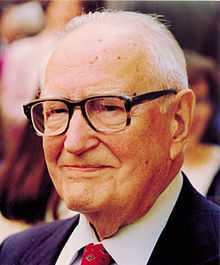Giles Rich
| Giles Sutherland Rich | |
|---|---|
 | |
| Judge Giles Sutherland Rich in 1994, age 90 | |
| Judge, Court of Appeals for the Federal Circuit | |
| In office September 1, 1982 – June 15, 1999 | |
| Judge, Court of Customs and Patent Appeals | |
| In office 1956 – September 1, 1982 | |
| Nominated by | Dwight Eisenhower |
| Personal details | |
| Born | May 30, 1904 |
| Died | June 15, 1999 (aged 95) |
| Alma mater | Harvard College Columbia Law School |
Giles Sutherland Rich (May 30, 1904 - June 15, 1999) was a judge on the United States Court of Customs and Patent Appeals (CCPA) and later on the United States Court of Appeals for the Federal Circuit (CAFC), and arguably had more influence than any other individual on modern U.S. patent law.
Rich was born May 30, 1904 in Rochester, New York. He received a B.S. from Harvard College in 1926 and an LL.B. from Columbia Law School in 1929, and began working as a patent attorney at his father's New York City law firm that same year. He soon also began guest lecturing on patent law at Columbia University, and during the late 1940s, he became the president of the New York Patent Law Association, and in 1947 became part of a two-person committee to draft a new U.S. patent statute, all while continuing to practice law full-time. His partner on the statute drafting committee was Pasquale Joseph Federico, the chief patent examiner of the U.S. Patent Office. After four years of work, Rich and Federico's statute draft was introduced in Congress by Joseph Bryson (D-SC) in 1951. After passing both houses without debate, as part of a "consent bill", it was signed into law by President Truman in 1952, to take effect in 1953. It was the first full revision of U.S. patent law since the Patent Act of 1836.
In 1956, Rich was nominated by President Dwight Eisenhower to become a judge on the U.S. Court of Customs and Patent Appeals (CCPA), which had jurisdiction for certain cases from the U.S. Patent Office, the U.S. Customs Court, and the U.S. International Trade Commission. He served as chief judge of the CCPA for part of that time, and was also an adjunct professor at Georgetown University from 1963 to 1969. Upon passage of the Federal Courts Improvement Act of 1982, the CCPA and the appellate division of the Court of Claims were merged into the new Court of Appeals for the Federal Circuit (CAFC), and six judges from the CCPA, including Judge Rich, were transferred to the CAFC. Judge Rich served on the CAFC until his death in 1999. At 95, he had become the oldest living federal judge; he never took senior status, by which most judges of advanced age effectively retire.
Judge Rich's judicial opinions include some of the most groundbreaking, influential, and controversial to modern U.S. patent law. He wrote opinions in which the court struck down prior rules against the patenting of living things (Chakrabarty v. Diamond), software-implemented inventions (In re Diehr), and business methods (State Street Bank v. Signature Financial Group), saying those rules did not have a proper basis in the patent statute (which he had co-written), and opening the way for inventors to receive patents in those areas of subject matter. (The earlier two of these decisions were later affirmed by the U.S. Supreme Court; see Diamond v. Chakrabarty and Diamond v. Diehr.)
In re Diehr and especially State Street Bank v. Signature Financial Group are highly controversial decisions. Many in the academic and legal community think that the cases were wrongly decided and are examples of judicial activism on the basis of a pro-patentee agenda, and the legal reasoning utilized in these decisions has been severely criticized.[1] For example, in State Street Bank v. Signature Financial Group, Judge Rich justified his conclusion on the basis that the business method exception to patentability was abolished by the 1952 Patent Act. However, this line of reasoning is contradicted by Judge Rich himself, among others. He had earlier stated, in a law review article written not long after the passage of the 1952 Patent Act -- "The Principles of Patentability", 28 Geo. Wash. L. Rev. 393 (1960)[2]—that Section 101 of the Act denied patent protection to business methods, observing that the diaper service, "one of the greatest inventions of our times," was patent-ineligible because it was a business method. The State Street decision was substantially overruled in the Federal Circuit's 2008 decision in In re Bilski.
A prominent annual intellectual property moot court competition, run by the American Intellectual Property Law Association, starting in 1973, was named after him.
References
- ↑ See, for example, R. Hulse, Patentability of Computer Software After State Street Bank & Trust Co. v. Signature Financial Group, Inc.: Evisceration of the Subject Matter Requirement, 33 U.C. DAVIS L. REV. 491 (2000); Pamela Samuelson, A Manifesto Concerning the Legal Protection of Computer Programs, 94 COLUM. L. REV. 2308 (1994); Rafael X. Zahralddin, The Effect of Broad Patent Scope on the Competitiveness of United States Industry, 17 DEL. J. CORP. L. 949 (1992); Pamela Samuelson, Benson Revisited: The Case Against Patent Protection for Algorithms and Other Computer Program-Related Inventions, 39 EMORY L.J. 1025 (1990). See also Law School Symposium,("[Professor] Sarnoff denounced as 'judicial activism' the Chakrabarty court's expansion of statutory language.”).
- ↑ .
External links
- Federal Judicial Center CCPA entry on Giles Sutherland Rich
- Giles Rich at the Biographical Directory of Federal Judges, a public domain publication of the Federal Judicial Center.
Bibliography
Rich, Giles S. (1980). A brief history of the United States Court of Customs and Patent Appeals. Washington, D.C.: Published by authorization of Committee on the Bicentennial of Independence and the Constitution of the Judicial Conference of the United States : U.S. G.P.O.
|